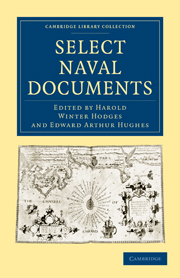Book contents
- Frontmatter
- Preface
- Contents
- LIST OF PLATES
- ILLUSTRATIONS IN THE TEXT
- ABBREVIATIONS
- HENRY VIII
- ELIZABETH
- JAMES I AND CHARLES I
- THE COMMONWEALTH AND PROTECTORATE
- THE RESTORATION NAVY
- WILLIAM III AND ANNE
- THE PEACE PERIOD AND NEED FOR REFORM
- WAR OF AMERICAN INDEPENDENCE, 1778–1783
- REVOLUTIONARY AND NAPOLEONIC WARS
- INDEX
WILLIAM III AND ANNE
Published online by Cambridge University Press: 07 September 2010
- Frontmatter
- Preface
- Contents
- LIST OF PLATES
- ILLUSTRATIONS IN THE TEXT
- ABBREVIATIONS
- HENRY VIII
- ELIZABETH
- JAMES I AND CHARLES I
- THE COMMONWEALTH AND PROTECTORATE
- THE RESTORATION NAVY
- WILLIAM III AND ANNE
- THE PEACE PERIOD AND NEED FOR REFORM
- WAR OF AMERICAN INDEPENDENCE, 1778–1783
- REVOLUTIONARY AND NAPOLEONIC WARS
- INDEX
Summary
Of the many illustrations of strategic problems furnished by this period, the best known is the Beachy Head campaign, the starting-point for all discussions of ‘a fleet in being.’ The phrase was coined by Torrington on this occasion; the idea, if not new, had never been so clearly expressed.
TORRINGTON EXPLAINS HIS STRATEGY
The Earl of Torrington to the Earl of Nottingham, June 26, 1690 (Quoted in The Earl of Torrington's Speech to the House of Commons, In November, 1690, published 1710.)
My Lord,
Every day since my last we have been in sight of the French fleet. Tuesday we were strengthened with Admiral Evertsen, two Dutch, and two English men-of-war, in all five. Wednesday morning with the day we got under sail with 55 men-of-war and 20 fireships, the wind easterly, with intention to attack the French; but the morning proved so hazy that we were forced to anchor again. The wind came about to the south-west, and in half an hour it cleared up again. Then we saw the French fleet in a line under sail about three leagues from us to the windward. We got immediately under sail, and stood upon a line to the southward, the Blue having the van. The wind favouring us a little, I saw a probability of weathering two-thirds of the French fleet, and made a sign for the fleet to tack, which they accordingly did, and stood directly with them.
- Type
- Chapter
- Information
- Select Naval Documents , pp. 90 - 115Publisher: Cambridge University PressPrint publication year: 2009First published in: 1922



